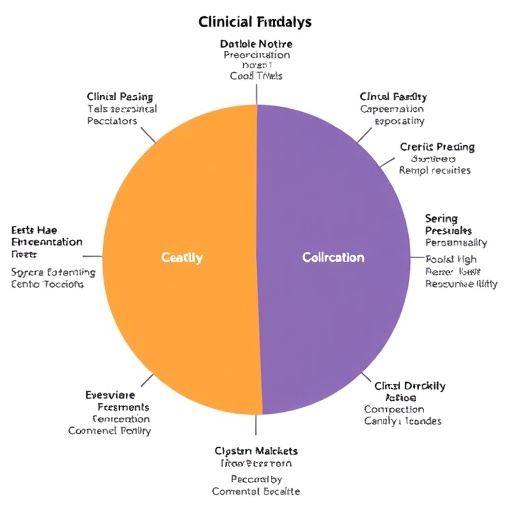In a groundbreaking study published in BMC Medical Education, recent research dives into the intricacies of clinical internship curriculum systems through a comparative analysis rooted in the four-component instructional design (4C/ID) framework. This scientific inquiry, conducted by a team led by Cheng and co-authors Han and Yuan, represents a significant step forward in understanding how clinical internships can be effectively structured to foster better educational outcomes for medical students.
The 4C/ID model, a pedagogical framework addressing complex learning environments, offers a robust lens through which to evaluate curriculum effectiveness. This model is structured around four key components: learning tasks, supportive information, just-in-time information, and sequencing. By employing this model, the researchers were able to dissect different internship structures across various medical education institutions, revealing insights that have direct implications for educational best practices.
At the heart of the study lies the realization that variations in internship curricula can significantly impact student learning experiences and outcomes. The researchers meticulously gathered data from numerous medical schools, examining how each institution deployed its internship framework. The analysis aimed to identify patterns and disparities that could be optimized for more effective training of future healthcare providers.
One striking finding from the analysis was the diverse implementation of learning tasks inherent in clinical internships. Some institutions adopted a hands-on approach, allowing students to engage directly with patients early on in their training. Others, however, followed more traditional methods, opting for observational roles that delayed active participation. This discrepancy highlighted a need for a more standardized approach that prioritizes early engagement and practical experience.
Supportive information is another critical element outlined by the 4C/ID framework, and this study emphasized its role in enhancing the internship experience. The researchers noted that well-structured informational resources—ranging from instructional manuals to digital platforms—can greatly assist interns in navigating their responsibilities. This is particularly important in high-stakes environments where quick decision-making is required, and students must have immediate access to pertinent knowledge.
Just-in-time information, which pertains to the provision of relevant data precisely when needed, emerged as another focal point in the study. Effective internship curricula were those that integrated systems enabling easy access to critical information during patient interactions. By employing dynamic knowledge resources, future healthcare professionals can improve their clinical decision-making skills while ensuring patient safety is prioritized.
The sequencing of tasks also played a pivotal role in the overall structure of the internship systems analyzed. The research underscored the importance of a carefully curated sequence that transitions students from simpler to more complex tasks. This scaffolding not only helps students build necessary competencies but also ensures a gradual increase in the complexity of situations they face, thus preparing them for real-world challenges in healthcare settings.
The implications of this research extend beyond academic interest; they directly speak to medical schools seeking to refine their curricula. By grounding their internship frameworks in the principles identified in the 4C/ID model, institutions can design programs that are more conducive to effective learning. The competitive nature of medical education demands that schools not only attract students but also ensure they leave the program ready to contribute meaningfully to the healthcare system.
The authors of the study advocate for a collaborative approach in curriculum design, encouraging institutions to share insights and successful practices. As they pointed out, fostering a community of learning among medical schools could catalyze widespread improvements in internship systems, ultimately benefiting patient care and health outcomes across the board.
Moreover, the study calls for ongoing research into the longitudinal impacts of different internship structures on career trajectories for graduates. Understanding how these curricula influence long-term professional development could provide valuable insights into further refining educational practices.
As the landscape of medical education continues to evolve, it is imperative that stakeholders remain committed to evidence-based practices. The findings from Cheng and his colleagues represent a clarion call to educators, administrators, and policymakers—they must prioritize the development of robust, engaging, and effective clinical internship curricula that prepare the next generation of healthcare providers for the complexities of modern medicine.
With the increasing emphasis on interprofessional education and collaborative practice in healthcare, the study also signals the importance of integrating interdisciplinary components into clinical internships. By exposing students to varied professional perspectives within the same educational environments, medical schools can enhance their curricula to reflect the collaborative nature of contemporary health care.
For educators and curriculum designers, adapting to these insights presents both challenges and opportunities. The call for innovation in medical training is resonant—while traditional methods have their place, the rapidly changing healthcare landscape necessitates a rethinking of how clinical education is delivered.
Ultimately, this research not only sheds light on existing discrepancies but also paves the way for future studies aimed at enhancing the learning experience for medical students worldwide. The commitment to refining clinical internship curricula through evidence-based strategies has the potential to transform medical education fundamentally and improve patient care outcomes in the years to come.
In conclusion, the comparative analysis presented in this research is a vital contribution to the body of knowledge surrounding medical education. By applying the 4C/ID model to clinical internships, the authors present a framework for designing effective educational experiences that can better prepare students for their future roles. As medical education continues to adapt and evolve, it is essential that we ground our innovations in solid research, ensuring that our future healthcare leaders are well-equipped for the challenges ahead.
Subject of Research: Clinical internship curriculum systems
Article Title: Clinical internship curriculum systems: a comparative analysis on the 4C/ID perspective
Article References:
Cheng, T., Han, Y., Yuan, W. et al. Clinical internship curriculum systems: a comparative analysis on the 4C/ID perspective. BMC Med Educ 25, 1257 (2025). https://doi.org/10.1186/s12909-025-07810-7
Image Credits: AI Generated
DOI: 10.1186/s12909-025-07810-7
Keywords: Clinical internships, medical education, curriculum design, 4C/ID model, clinical training, healthcare education, pedagogical frameworks.




